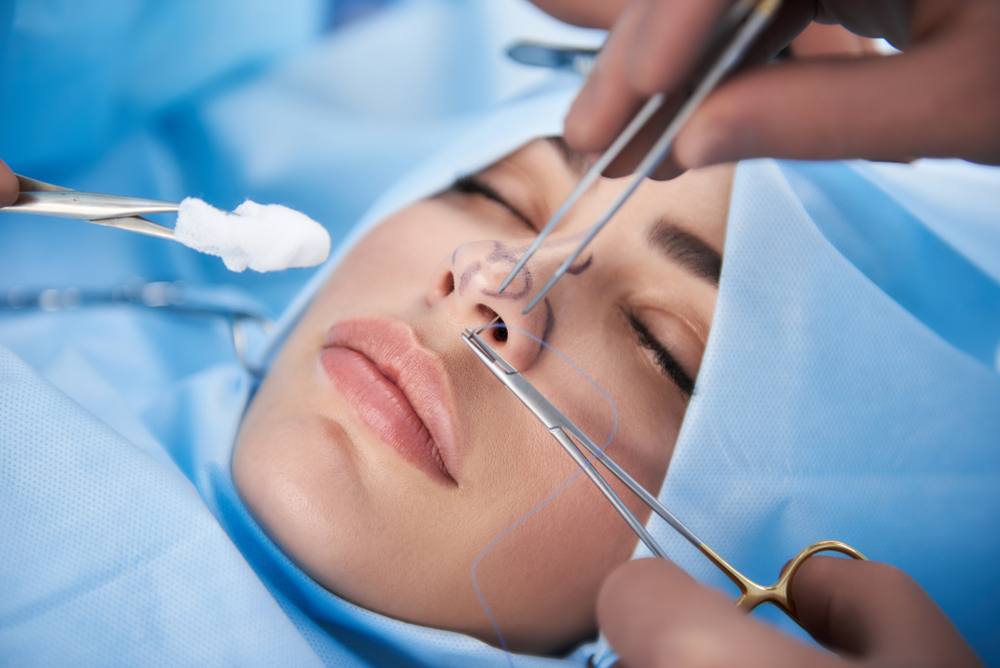Are you considering getting a tipplasty in Turkey? Look no further than HealTrip Global. With a team of experienced and skilled plastic surgeons, HealTrip Global offers safe and effective tipplasty procedures with natural-looking results.

Recovery from tipplasty, also known as nasal tip surgery or rhinoplasty of the nasal tip, typically involves a process that allows patients to heal and enjoy the results of their procedure. After undergoing tipplasty, patients can expect the following recovery experience:
Immediate Post-Operative Period: Immediately following tipplasty, patients may experience some discomfort, swelling, and bruising around the nasal tip and possibly the surrounding areas. Pain medication and cold compresses are often prescribed to manage these symptoms.
Rest and Recovery: Rest is crucial during the initial days after tipplasty to promote healing and minimize swelling. Patients should avoid strenuous activities and keep their head elevated to reduce swelling.
Swelling and Bruising: Swelling and bruising are common side effects, but these usually peak within the first few days and gradually subside over the following weeks. Keeping the head elevated and following the surgeon's post-operative instructions can help minimize these effects.
Diet and Medications: Patients may be advised to follow a soft diet to avoid any strain on the nasal area during chewing. Additionally, prescribed medications, including antibiotics to prevent infection and pain relievers, should be taken as directed.
Stitches and Dressings: Any external stitches or dressings applied during the procedure are usually removed within the first week after surgery. Internal sutures, if used, may dissolve on their own.
Return to Normal Activities: Most patients can return to their normal daily activities within one to two weeks, although strenuous exercise and activities that risk injury to the nose should be avoided for a longer period.
Follow-up Appointments: Patients are typically scheduled for follow-up appointments with their surgeon to monitor the healing process and ensure that everything is progressing as expected.
Long-Term Results: While the initial recovery phase is relatively short, it may take several months to a year for the full results of tipplasty to become apparent as residual swelling gradually subsides. Patients should be patient and follow their surgeon's advice for the best possible outcome.
Nasal tip rotation refers to the upward or downward movement of the nasal tip, altering the angle between the upper lip and the tip of the nose. This surgical procedure is commonly performed in rhinoplasty to enhance the aesthetic appearance of the nose. Increasing tip rotation can create a more refined, lifted appearance while decreasing rotation can lead to a softer, less upturned look.
Skilled plastic surgeons carefully assess facial proportions and individual anatomy to achieve a harmonious and natural result, taking into consideration the patient's preferences and overall facial features. Nasal tip rotation is a nuanced procedure that requires precision and expertise to achieve the desired cosmetic outcome.
Nasal tip plasty, also known as tip rhinoplasty, is a surgical procedure focused on enhancing the appearance of the nasal tip. It is a subset of rhinoplasty, a cosmetic surgery that reshapes and refines the nose. Nasal tip plasty specifically addresses the tip of the nose, which plays a crucial role in defining the overall nasal aesthetics.
During a nasal tip plasty, a skilled plastic surgeon can make various adjustments to achieve the desired outcome. Common modifications may include refining the shape of the nasal tip, reducing or augmenting its size, correcting asymmetry, and improving the angle between the nose and upper lip. These subtle changes can have a significant impact on the overall balance and harmony of the face, enhancing the patient's facial appearance while preserving their natural beauty.

| Step | Description |
| Anesthesia | Local anesthesia with sedation or general anesthesia is administered. |
| Incision | An incision is made either inside the nostrils or on the outside of the nose. |
| Access to Cartilage | The cartilage is accessed through the incision. |
| Sculpting and Reshaping of Cartilage | The surgeon sculpts and reshapes the cartilage to achieve the desired tip shape. |
| Sutures | The incision is closed with sutures. |
| Splint | A splint is placed on the nose to help support the new shape during the healing process. |
| Pre-operative Checklist for Tipplasty Candidates |
| - Consult with a board-certified plastic surgeon |
| - Discuss medical history, medications, and previous surgeries |
| - Stop certain medications or supplements as directed |
| - Avoid smoking and drinking prior to the procedure |
| - Arrange for transportation to and from the clinic |
| - Follow any additional instructions provided by the surgeon |
 Summary
Summary 
Like any surgical procedure, tipplasty carries some risks and possible complications. These risks can be minimized when the procedure is performed by a skilled and experienced surgeon, with proper preoperative evaluation, planning, and postoperative care.
Some of the possible risks and complications of tipplasty are:
Bleeding: Although rare, excessive bleeding may occur during or after the procedure, and in some cases a blood transfusion may be necessary.
Infection: Infections can occur in any surgical procedure, and antibiotics are typically prescribed to minimize this risk.
Scarring: Despite efforts to minimize scarring, a visible scar may remain after the procedure.
Septal perforation: In rare cases, the nasal septum (the thin wall that separates the nostrils) may be perforated during the procedure, and additional surgery may be required to repair it.
Asymmetry: The final result may present a certain degree of asymmetry, but this can usually be corrected with revision surgery.
To minimize the risks of rhinoplasty, it is important to follow all pre-operative and post-operative instructions provided by your surgeon. This includes avoiding smoking and drinking, taking prescribed medications as directed, and avoiding any strenuous physical activity or exercise for a period of time after the procedure. It is also important to choose a qualified and experienced surgeon with a proven track record of successful rhinoplasty procedures.
To manage these risks and side effects, it is important to follow the preoperative and postoperative instructions provided by your surgeon. Before the procedure, you may be asked to stop certain medications, stop smoking, and avoid alcohol to reduce the risk of complications. After the procedure, you will be given specific instructions on how to care for your incisions, including keeping the area clean and dry, avoiding certain activities, and taking pain medication as prescribed.
Applying cold compresses to the treated area can help reduce swelling and bruising. In some cases, your surgeon may recommend the use of a nasal splint or bandage to support the nose and aid in healing. It is important to keep all follow-up appointments with your surgeon to monitor your progress and address any concerns or issues that may arise. If you experience any persistent pain, swelling, or other unusual symptoms after rhinoplasty, it is important to contact your surgeon immediately.
At HealTrip Global, we work with highly-skilled plastic surgeons specializing in rhinoplasty and other cosmetic procedures in Turkey. Our team of experts will guide you through every step of the process, from selecting the right surgeon to post-operative care. You can rest easy knowing that you are in good hands and that your safety and satisfaction are our top priorities.
After a tipplasty procedure, patients can expect some swelling and bruising around the nose area. Pain, discomfort, and congestion may also be experienced in the first few days after surgery. In Turkey, patients are usually advised to take a week off from work or school to properly recover.
During the recovery period, it is important to follow all post-operative care instructions provided by the surgeon to ensure proper healing and minimize the risk of complications. This includes keeping the nose elevated at all times, avoiding strenuous activities, and refraining from smoking or drinking alcohol.
Patients will also be required to attend follow-up visits with their surgeon in Turkey to monitor their progress and ensure that healing is going as planned. The length of the recovery period will vary from patient to patient, but most patients can expect to see final results within six months to a year after the procedure.
Patients should keep in mind that the results of tipplasty may not be immediately noticeable due to swelling and bruising. It can take several weeks to months for the swelling to fully subside and for the nose to fully heal. However, patients can expect to see some initial improvements in the appearance of their nose within the first few days of the procedure.
Final results of tipplasty can take up to a year to fully manifest, as it takes time for the tissues to fully heal and for the nose to settle into its new shape. It's important for patients to have realistic expectations about the timeline for results and to follow all post-operative instructions carefully to ensure a successful recovery.
To summarize, here are some tips for a smooth recovery period after tipplasty:
In conclusion, tipplasty is a popular cosmetic procedure in Turkey that can improve the appearance and balance of the nose. While the recovery period can be uncomfortable, following post-operative care instructions and attending follow-up visits can ensure a smooth and successful recovery.
After a Tipplasty procedure, patients should follow specific instructions to ensure a safe and smooth recovery. In general, patients should avoid any physical activities and exercise that can raise their heart rate and blood pressure for at least a week after the procedure. This includes any strenuous activities such as running, lifting weights, or participating in sports.
Exposure to direct sunlight should also be limited during the first few weeks after surgery. Patients should wear sunscreen and a hat when outside and avoid prolonged exposure to the sun.
Smoking and alcohol consumption can have negative effects on healing and can increase the risk of complications after surgery. Therefore, it is strongly recommended to avoid smoking and drinking alcohol for at least two weeks before and after the surgery.
Additionally, patients should follow their surgeon's instructions carefully regarding proper wound care, medication management, and any post-operative appointments. Any concerns or questions that arise during the recovery period should be addressed with the surgeon or medical staff promptly.
It is important to note that the recovery period may vary depending on the individual, the extent of the procedure, and other factors. However, following these instructions can help ensure the best possible outcome and minimize the risk of complications.
In Turkey, many clinics and hospitals offer Tipplasty procedures with experienced and skilled surgeons. With proper care and follow-up, patients can achieve their desired results and enjoy a more confident and aesthetically pleasing appearance.
Tipplasti, daha dengeli ve estetik açıdan hoş bir yüz görünümü elde etmek için burun ucunu yeniden şekillendiren ve geliştiren kozmetik bir cerrahi prosedürdür. İşlem, gelişmiş yüz uyumu, artan özgüven ve daha rafine bir burun ucu gibi bir dizi fayda sunar.
Tipplasty prosedürünüz için HealTrip Global'i seçerek, aynı prosedürün diğer ülkelerdeki maliyetinin çok altında, en yüksek puan alan hastanelere ve yüksek vasıflı plastik cerrahlara erişebileceksiniz.
HealTrip Global'de kendimizi müşterilerimize yüksek kaliteli tıbbi bakım sağlamaya adadık. Uzmanlardan oluşan ekibimiz, doğru cerrahı seçmekten seyahatinizi ve konaklama yerinizi ayarlamaya kadar sürecin her adımında size rehberlik edecektir. Tipplasty aracılığıyla hayalinizdeki görünüme ulaşmanıza nasıl yardımcı olabileceğimiz hakkında daha fazla bilgi edinmek için bugün bize ulaşın.
>